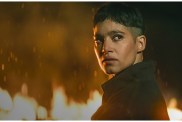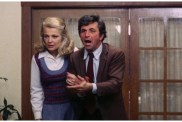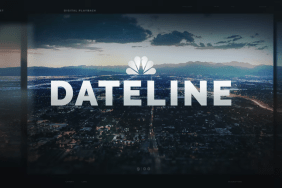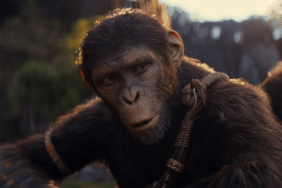Night School: Actor Drew Snyder remembers making 1981 female-centric slasher saga
Part Two (read Part One here):
1981 was an excellent and diverse year for horror – many classic favorites popped up and provided audiences with scares whilst impressing critics. Some of these films called upon past movie monster tropes such as an outing for werewolves with The Howling, Wolfen and An American Werewolf in London, some delivered a visceral onslaught of terror such as The Evil Dead and The Beyond, while during the heyday of the slasher boom, films such as Halloween II, Just Before Dawn, Happy Birthday to Me, The Burning, Absurd and more delivered the frenzied violence that rabid horror fans itched for. One of these slasher films from this great year in cinematic horror was Night School, which plays with tribal ritualistic killing, Giallo aesthetic and thematic tropes, the horror of personality and police procedural. This stylish slice’n’dice “whodunit” is also thoroughly injected with red herrings, and number one red herring is actor Drew Snyder, who spent some time with us talking about the shoot.
ComingSoon.net: What was Ken Hughes like as a director?
Drew Snyder: Well here is the thing about Ken. He was not like a Martin Scorsese who will come and like nurture you, like Barry Levinson, who will pull you off to the corner as friends of mine who worked on Avalon and say he would really kind of help you find the arch of your character. This was not Ken’s thing; you know what I mean? I can’t imagine being on the set of Cromwell, you know and keep thousands of people together, in the south of Spain with his megaphone! I have no idea. But, you know, Ken is like a miniature Richard Attenborough, when you think about it. I mean, he is in that great British director vain of just brilliant directing and the moving of people and placement of camera and angle and stuff. But I do now that you mention it think that the lighting is very, very good in this film and I think that is part of what Ken wanted to create in terms of his kind of suspense and feeling and everything else. Yeah, I can see the vivid colours, dark but vivid, you know what I’m saying? I can see so that there would be something I’m just thinking that I think I watched the film about three years ago and I looked at it and in a scene that was dark, whether it was dark because of something that was going to happen in the scene or just because if it was shot at night or something like that – there would always be this real bright element. They’d be a bright element within the frame. Yeah, the shoes and the rattling of the knife on the fence making the noise, all of those things are quite special. And I think that was Ken! I like was going to say knife pops along the fence making sound – I don’t remember. I have different found scripts from old things and stuff, but I don’t have that one.
CS: This was your first theatrical feature film – were you happy with the role and the way the production followed through?
Snyder: I had read the script, and I said, you know, well, this is what it is! I said, ‘I want to make something, I wanna make the jump from doing these small supporting roles to having a more, you know, leading role or a lead in a feature film’. I said, ‘There’s an advantage to that, and I think I need that!’ So to speak, in my rapporteur, my background or whatever, I’ll tell you a personal story. I was married at the time. I’m not married to that person, and the person sadly died very early. Anyway, the script came. I was sitting there with my wife and opened up the script without knowing it, just opened it up to page thirty-two or whatever it was, to the naked scene in the shower, and she said to me and said read it, she said, ‘If you do that I am going to divorce you!’ I said, ‘Get out of here! It’s just a film! Come on!’ I said, ‘What’s the big deal? It’s just a movie! It’s fake, you know? Don’t worry about it!’ I was happy to be able to work consistently on a character for you know, four or five or six weeks on a film, out of town, on location. I wanted what that experience was. I thought that that was a good thing to have. My background had really been theatre in New York, and I had been very fortunate with my work. I had been in a Tony Award Winning play on Broadway in 1972/’73, and you know, I had decided to come to Hollywood, but it was like starting all over. I said to somebody, ‘Well what is the last job you did?’ ‘Well, I did A Doll’s House in Lincoln Centre with Liv Ullmann. And they said, ‘Who is Leaf Ullmann?’ I said ‘No, not Leaf. I said Liv Ullmann’. She had just gotten the Academy Award for Scenes from a Marriage. It was right around that time, and she had done after that – when she came to America – she went and did A Doll’s House at Lincoln Centre. But that was my experience with like Hollywood, you know. I said Well I’m gonna come to Hollywood and it’s not going to be difficult to get an agent or anything else because they will see that I’m… it doesn’t work that way, I don’t know why! But you know, it is a whole different thing! I used to say that the difference between New York City and California was, you be unemployed and be walking down 57th Street in New York City and be invited to a party, but if you were unemployed in California and walking down Rodeo Drive in Beverly Hills or whatever and you saw somebody unemployed, they weren’t going to invite you to the party! So I always thought there was more of a sense of what being an actor was about or whatever in New York. There was an element of that. It wasn’t about your last job. So anyway, I was happy to take this job for those very reasons. And I became good friends with Rachel (Ward). That was great, you know. And I would talk to her. It was her first film job. She had been this major mega model, you know, on all those covers of Cosmo and everything else. So I don’t know if she had an acting teacher at the time or whatever but we would talk about scenes, we would talk about what the relationship was.
CS: Your character is a red herring – throughout the film it is implied that you are in fact offing the school girls and you play the role as though this may in fact be the case. What was your approach to this?
Snyder: Well, I think that was implied and written in there, but I think there is a scenes in that film that I think really kind of points that out. That’s the one – there is a tiny, little scene, in the beginning, I think in a third of the film, in the cafeteria or not a cafeteria but like in a diner where the girl brings coffee or brings something to the table, and I’m friendly with her and that’s the red herring, as you said, you know, that is thrown in Rachel’s direction. So it both is the red herring, but also Rachel’s character with the sense of jealously or whatever, you know that she is not enough for this guy or whatever. I look at that scene and actually, the work in that scene, actually the work in that scene – both her work and my work is pretty good because it is pretty unencumbered; it’s pretty simple, it’s not cluttered, it’s not acted, you know what I am saying, when I watch that scene again. I can see her consciousness and her stress that she feels about the relationship not being what she wants it to be. I get a sense of that. He seems to blow it off and be okay, you know.
CS: I love all the anthropological inserts in the film – the idea that your character is a professor of such studies and uses it in his day to day life; most notably the ritualistic sex scene in the shower. What were your thoughts on this element to the script?
Snyder: Well most of the movie dealt with head hunting! I liked that aspect! Wasn’t it in the Philippines just about fifteen-twenty years ago that they discovered the Casani people – the Casani were not even in the iron age, they were in the stone age! The thing that they did notice about them was that love terminated their whole society, and they were more gatherers and they would eat little crayfish out of the streams and stuff like that, but they were not even into an iron or bronze age or anything like that. They were still in the stone-age. I’m sure there were many stone-age people that were also violent that ended up having to kill a mastodon in order to eat or something, you know. I think all of that is interesting and supports kind of a textured element of a though-line in terms of… you know it is not arbitrary. Let’s put it that way, right? I mean just to shock people, so that all seems to make sense. I do think when you talk about the ancient sort of things like several native American tribes when they would kill their enemy, one of the things that they would do would be to eat their liver. They did that out of respect. So the cutting off of the head of somebody was not for a whimsical sort of thing, it was a thing to honour them. That is why they probably kept the head and dried them out and everything else. It was like to honour their enemies was to solidify their strength and their power. I do know that. I don’t want to mention a tribe that it’s not, they all didn’t do that. There is that scene in DANCES WITH WOLVES when he cuts the Buffalo, and he tries to get Kevin Costner to eat the liver there because it represents victory – that kind of thing. I know that they did that with people. Look at what the Romans did, you know the Romans used crucifixion and burning. Someone once asked me: “Burning?” and I said, “Yeah. If you were stupid enough to go to war they would keep one person aside, and they’d burn them so badly and allow them to crawl back to their village so that they could tell them.” Someone said how did this happen? Who did this?! They’d say, the Romans. So you wouldn’t mess around with them. The same way when the Romans used crucifixion. They couldn’t get down the road fast enough! So when the Romans would come, the people would say ‘Oh. Come on. Welcome! Welcome!’ You know? So all of that is kind of like elements of all of that that has been around. It’s not something new. I mean, the idea that a slasher film or those kinds of films, you know, in terms of part of what has happened in life and in humanity – man’s inhumanity to man has existed for a long time with symbolic and reasonable reason for what they thought was needed, you know? I think, I guess, it all had to do with control! All of it! Everything in life.
CS: The film often gets criticized by hardened slasher fans for not being violent enough – or not having enough onscreen gore – what are your thoughts on this?
Snyder: Here is what I would say. I don’t know who it was that said this to me, and they said it and I really heard what they said, it might have been Frank Capra Jr. who produced Firestarter, was saying when we were talking; he really loved film. He got that from his father, you know? He really understood film. But he said that there was nothing wrong with “copying” – or I don’t know if he used the word ‘’copying’’ scene that’s been done in another movie. He said ‘the thing is if you do it, you just want to make sure that you do it as well if not better!’ So I would say about the, from what you just said to me about the scene in the shower with the girl and the blood – we saw that right in the Hitchcock film with Anthony Perkins, Psycho. So, I’m not saying that Ken was thinking of Psycho, but what happens is if it works, you know, then it works! If it doesn’t work, then if you’re smart then that’s the thing. So I think all of that is important in terms of giving the audience enough but not answering everything fully and not spoon feeding them. I think one that would have more violence. I think the good thing about this film is that it is pretty violent. As I said, you get a lesbians head in a toilet bowl, you know, so how can you be more violent than that? It had nothing to do with being a lesbian or anything else; it’s really kind of like obtuse, I mean, it’s pretty out there! I think without having to see all of the gratuitous violence that becomes more a cartoon thing. I think your response to the feeling and the mood and the texture and everything that kind of solicits an emotional response when we watch it is a good thing. I think it’s a creative thing. More creative for this genre than other films and it doesn’t surprise me that it was up against The Howling for that fantasy and horror award, and this one, you know, it got an award of something for it. And I can understand that now. When I was doing it, I don’t think I fully saw it as that. I was not invited, but I don’t like to watch dailies because I think actors are pretty critical of themselves and they’ll see something that is already in the can and can’t be changed, and they’ll go back and try to make up for what they didn’t do in that scene that has already been shot! And they end up kind of throwing themselves off in terms of an arc that they are trying to create with the character that they are developing, I think. There’s a great film; I can’t remember what it was… Dustin Hoffman. He went, and he went to see the screening of this film for the directors cut or the rough cut or the first cut or whatever. He said, “That’s not the film I made!” And they said, “What do you mean? What do you mean? That’s you! That’s you up there!” He said, “No. No. We did that other take, and that other take that we talked about that was more right for the character”, And so he saw that what he was working on never made it to the screen, so I can understand why, really, big, powerful actors within the industry want to have some sort of say, because it was not the character they were trying to create. And all the little nuances, all the small things. Rachel’s feeling uncomfortable in that scene in the coffee shop. If someone else had cut the film, maybe they would cut that out, you know? So it makes sense to me. But I don’t like to go see things, you know? ‘Oh sh*t! I could have done that better! No. Why didn’t I think about that line when I was saying it so I could have a feeling of nobody else knows that. It sounds real phoney to me versus living the character, you know, versus, you know, saying the words in the script and hoping that the shot and the location and everything else is going to make up for it!
CS:What was it like working on Firestarter? What memories do you have from that shoot?
Snyder: Oh it was great. I came on with Mark Lester. Somebody on Facebook said to me … he said, “We saw you on the late show with Stephen Colbert!” I said, “Get out of here! I said, “I haven’t done anything on The Late Show!” And he said, “Oh yes, yes. You’re on there.” So write this down because you will look this up on Youtube – it’s ‘Proof That Trump Fights Fire With Fire.’ You’ll find a clip from Firestarter, with Donald Trump setting me on fire that they used as the teaser on The Stephen Colbert Show! It’s very funny! I look at him and say, “Noooo! Don’t!” Then he sets me on fire. It’s the scene with Drew Barrymore setting the FBI agents on fire, at the farmhouse. I look at that film, and you know, it’s not a bad film! The actors that it had in that film, it had – Martin Sheen. It had George C, Scott. It had Drew Barrymore. It had David Keith. It had Louise Fletcher from Cuckoo’s Nest. It had Art Carney. It just has this incredible cast of people that they got to do it! And it was the first thing that Dino De Laurentiis did in Wilmington, down there. He did KING KONG down there and stuff. And I got to work. There is a scene in the beginning of that film – and I’ve watched it – it was the guy… it was the first scenes where they had used the Steadicam on film. And it is at the beginning when David Keith is running through a busy area in a downtown area or something like that with the girl, with Charlie. And you can see the guy following them with the Steadicam, and we’re following, and the agents are following him also. But I saw this apparatus that was on this guy, with all these gyros and everything, and they told me. Now it’s like standard for people to use. They do it all the time because it’s such an incredible great piece of film apparatus to be able to do a ten-minute shot without a break. I was one of the FBI agents. All the FBI agents were all stunt people; they weren’t really actors. And at that time the stunt union was not apart of the actors guild – that didn’t mean that they couldn’t. Some of the stunt guys don’t act, and some of them do. I mean, they are able to do both, you know? But they are a totally different breed; they’re like somebody out in the outback, you know what I’m saying? They’re like rodeo guys. I had to stop going out with them. They wanted to go to bars, and they would get in fights all the time, and I said, “I can’t!” And they’d say, “What’s it to ya! Go ahead, throw that bottle over there!” I said, “I can’t do that. I said, ” I have to do lines.” I said, “You guys don’t have to worry about that. You gonna be lit on fire.” I said, “I have to say lines. It’s my face on camera. I can’t go out with you guys anymore.” So it’s really very funny.
To be continued…









